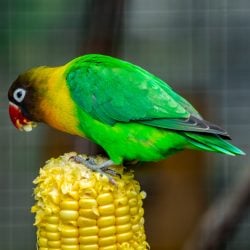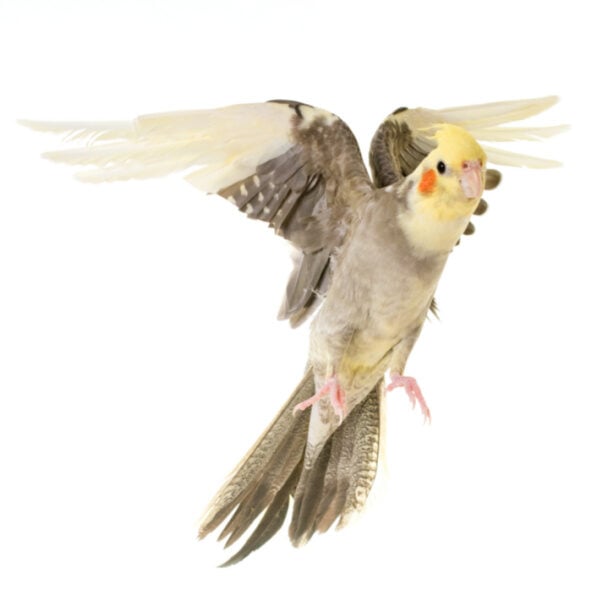Last Updated on by Mitch Rezman
I have had my male African grey parrot for 28 years.
When he matured sexually years ago he started plucking.
I have him on a plumage supplement now and he has lots of new quills and looks much better.
However, he humps my arm with a thick sweater on.
He goes to completion if I let him once a day.
I have heard there is a hormone to calm him as he is definitely oversexed.
He has claimed me as his mate and is very sweet but needy.
He keeps getting new red tail feathers (which tells us he’s a Congo Grey) but chews on them until they are not pretty anymore.
In the past, I tried getting him used to other birds but they never bonded.
Now at his age I know it’s too late to breed him.
Any help would be appreciated. Also, he is on a seed diet although I remove peanuts.
I would love to try weaning him to a pellet diet but don’t know which kind to buy and how to introduce it.
He has flight feathers but his chest is only down due to chewing.
I know he hasn’t damaged follicles as the feathers do try to grow back.
Especially with the plumage supplement which is only certain different seeds.
Thanks
Dear Patricia
The hormone you are referring to is most likely Lupron.
We think Lupron, a drug developed to assist pre-pubescent girls with physical growth is totally inappropriate for birds, here’s why.
It is always difficult when we have a pet whose hormones are out of whack.
Your grey sounds very frustrated.
He has obviously accepted you as its mate and not just a flock mate. You need to change this.
How do you pet him?
Parrots must be stroked only from the neck up and they will enjoy the contact there as they can’t reach their heads themselves.
Petting below can be construed as foreplay and get the bird excited.
No cuddling, hugging, swaddling. They are not human babies.
Having a sexually charged male can be easier to deal with than a female as egg production can be fatal over time to a single female bird stuck in high hormones.
I recommend that you do not allow the bird to have sex on your body.
Instead, toss a few whiffle balls in the cage and let him try to enjoy them.
He may choose a cage bar, perch or toy to use instead, just let him.
What plumage supplement are you using?
A good one to help with feather growth is Nekton Bio Protein.
Yes, a supplement is useful to feed the regrowing feathers, but it may not affect his picking and barbering.
Otherwise, the constant masturbating can be bothersome to you it may not be a life-threatening problem unless he begins to pick too much and injure his skin.
Not allowing him to masturbate on you or feed you (if he does) may help.
Holding off on the touching below the neck may help.
This webpage Hormones and Your Parrot: the Triggers and What to Do, offers a lot of useful information on hormonal problems.
We have had good results with this light treatment for our female cockatiel and I do not know if it would work for a male bird although I don’t see where it would hurt to try.
It requires subjecting your bird to 3 days and nights (72 hours) of continuous bright cage light.
No tents, no bedding, no shade.
This causes their natural circadian rhythm to be broken and the reproductive cycle gets shut down.
It cannot hurt and costs nothing but a good Full Spectrum Bulb and a little time. Plus a squawking parrot at 2 am but it is only 3 days.
If you try this I would like to know how it goes.
Pellets are a good food to get your bird on for at least a part of its diet, select a pellet, any pellet and make a small dish of them available every day.
Choosing a pellet that is already in the seed mix that you feed your bird can make converting to more pellets easier.
Higgins makes their Intune Parrot Pellets available in separate bags and they then can be increased in quantity as your grey starts to eat more of them. The Intune pellets work well with both of these seed mixes to create a better diet.
Higgins Sunburst Parrot and Higgins Safflower Gold are excellent blends for your grey.
In the evening take out the seed dish and leave just the pellets in at night, the next morning you can return the seed dish to the cage.
This may help get the bird to try them when they are hungry during the night.
If your bird will take treats from you, use the pellets, he may like them hand fed. It is a good start.
Thank you
Catherine
Author Profile
Latest entries
 Feeding Exotic BirdsJune 20, 2025Is Corn On the Cob Safe for Pet Birds?
Feeding Exotic BirdsJune 20, 2025Is Corn On the Cob Safe for Pet Birds? Bird & Parrot AnatomyJune 19, 2025Would You Like a Comprehensive Guide for Training Your Bird?
Bird & Parrot AnatomyJune 19, 2025Would You Like a Comprehensive Guide for Training Your Bird? Feeding Exotic BirdsJune 19, 2025Here Are Three (Video) Strategies to Help Your Bird Forage
Feeding Exotic BirdsJune 19, 2025Here Are Three (Video) Strategies to Help Your Bird Forage Bird BehaviorJune 13, 2025Why Do Some Parrots Struggle in Captivity?
Bird BehaviorJune 13, 2025Why Do Some Parrots Struggle in Captivity?




